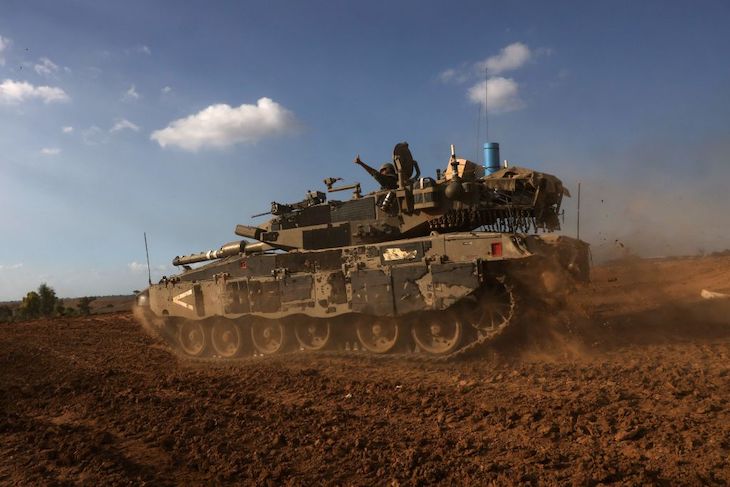A four-day pause and the release of 150 Palestinian prisoners. Seen from London or New York, this seems like a reasonable measure to secure the return of 50 Israeli hostages. Pause the fighting; allow humanitarian aid to reach Gaza; satisfy the Americans, who were reportedly pushing hard for the deal; get a good number of your citizens back. What’s not to like?
The reality, however, is somewhat more complicated. A four-day pause in fighting is not a static affair. At least, it may be for the IDF, but it isn’t for Hamas. They will spend the time resupplying, including seizing as much aid as they need from humanitarian convoys entering the territory. Moreover, as part of the deal, Israel agreed to stop its aerial surveillance of the south of the Strip for a period each day, allowing its enemy to prepare the next battlefield without being observed. What surprises will Israeli troops face when they pursue their adversaries into the civilian areas in the south?
As Israel’s soldiers sit on their tanks playing cards, sleeping, calling their families and singing to keep up their morale, they will find themselves in greater danger by the hour. Hamas spotters will be wasting no time in observing their positions, taking photographs, learning from their formations and drawing up tactics for the next phase of the fighting.
Any incoming small arms fire will place the IDF in a quandary. Was it significant enough to count as a break in the ceasefire? Was it carried out by Hamas and its allies, or simply a Gazan resident? Can Israel risk a response? As ever, Israel is placed in a position of trying to uphold the highest standards of humanity while facing an enemy that not only views basic morality with disdain but seeks to weaponise it against the Jewish state. Weighing heavily on the minds of Israeli generals will be the case of Hadar Goldin, who was ambushed and killed by Hamas in 2014 just hours after a supposed ceasefire had been brokered by the United Nations (Hamas, of course, disputes the detail). Nine years on, the terror group continues to hold his body in Gaza.
Politically, the question has been a thorny and agonising one for the Netanyahu cabinet. Israel has two war aims: to wipe out Hamas and free the hostages. Which is the priority has been a matter of painful dispute. Everyone agrees that the days of exchanging 1,000 Palestinian prisoners for one Israeli are well behind us; the value of a hostage must be reduced to repress the incentive for taking them. And everyone agrees that the continued existence of Hamas presents an intolerable threat. But the doctrine of ‘fighting the war as if there are no hostages, trying to free the hostages as if there was no war’ is a difficult one to implement when the lives of 50 innocents are placed on the table.
The awful reality is that – as has been the case so often in Jewish history – there is no route that does not involve unbearable heartbreak. Everybody in Israel is paying a personal price. Will striking a deal to release hostages now cost the lives of soldiers? Will extending the timeline of the conflict give international outrage – manipulated by Hamas with the bovine cooperation of the western media – more time to build towards a political tipping point? Will it allow Hamas to survive and capture more hostages in the future?
This is a country where universal heartache hardens all calculations. Take, for example, the words of an old school friend living in Jerusalem: ‘I can send my son to risk his life fighting for our nation. But I can’t send him to throw his life away for the whim of politics… If Bibi had even the slightest intention of [destroying Hamas], he would not agree to a ceasefire that undoes all the work our soldiers have done to reach this point.’
Yet for all the sacrifices made by the Israeli side, the greater truth is that Hamas is weak. This morning, while about to board a train to work, a Palestinian friend called me from Khan Yunis in southern Gaza, where he is sheltering with his family in a tent in the grounds of the hospital. ‘It shows how much Hamas (he used our codeword for the group) is weak,’ he said. ‘They are getting only three Palestinians for each Israeli. That is unbelievable.’ How many terrorists have been killed so far, I asked? ‘A lot,’ he replied. I wondered what the attitude was among the people of Gaza towards Hamas. ‘We are angry,’ he said. Few in Gaza would dare say this out loud, but this is another source of pressure with which the terror group must contend.
So far, the IDF has made much swifter progress in the war than anybody had expected, gaining control of Gaza city and, according to Israeli estimates, killing thousands of the enemy, which accounts for a large portion of the casualties reported by the media. That’s not to say it will be easy from here on. Many Hamas fighters have fled south to shape the battlefield in advance of an Israeli assault. There may be some unpleasant surprises ahead.
Fundamental to the terror group’s strategy will be Gazan civilians like my friend, who have fled into the south and are ripe for manipulation as human shields. From what I hear, the resentment this is causing among locals is not insignificant: one Palestinian told me last week that despite being injured – not seriously – in a strike ten days ago, he supported the Israeli offensive, as the only secure future for his children is one without Hamas.
From the Israeli point of view, one strategic objective is to reduce civilian casualties as much as possible, both for the sake of humanity and to quell international pressure. A plan is forming to create a safe zone in the southwest, on the border with Egypt, where a camp can be set up for displaced people and international aid can be distributed (Israel offered to set this up but was told that Gazans would not trust them, so the responsibility must be met by the international community). The injured may be treated across the border in Egypt, and aid ships, probably led by France, may anchor there off the Gaza coast.
But the hard fact remains that today’s hostage deal has been secured not by negotiation and compromise but by intense military pressure. In the years since it withdrew unilaterally from the territory, Israel has tried to win over the people of Gaza by providing economic stimulus alongside a necessary military blockade. More than 10,000 Gazans have been entering Israel daily to work, taking higher wages back to their families, and the Strip has been provided with water and other resources. October 7th showed the extent of Hamas’s gratitude for such support.
It also presented the Israeli public with a sharp lesson. If a terror group has both the capability and the motivation, it is just a matter of time before it launches an attack. However intense the outrage from the complacent idiots in the international community, and however much pain lies along the way, only one option lies before the country. Victory.
Jake Wallis Simons is the author of Israelophobia: The newest version of the oldest hatred and what to do about it.







Comments